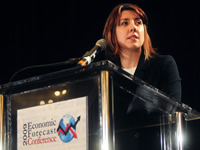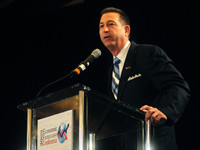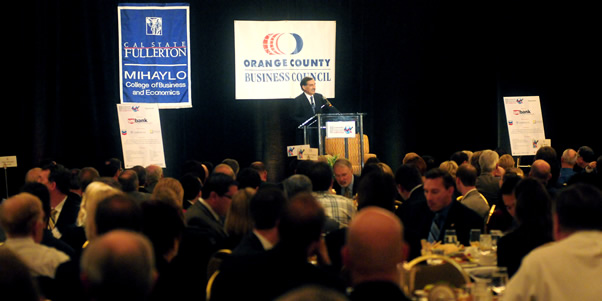Riding the Economic Roller Coaster
Annual Economic Forecast Puts Recovery a Year Away
November 11, 2008
By Pamela McLaren
"When all is said and done, 2008 will have earned a prominent spot in history as the year that fundamentally changed our capital markets and financial system.”
Anil K. Puri, dean of the Mihaylo College of Business and Economics at Cal State Fullerton, addressed more than 800 business, community and university leaders attending the 14th annual Economic Forecast Conference Oct. 30. Joining him was Mira Farka, assistant professor of economics, at the annual event sponsored by the college and the Orange County Business Council.

Mira Farka, assistant professor of economics at Cal State Fullerton, answers questions during the 2009 Economic Forecast Conference. Photos by Kelly Lacefield
The economist offered evidence of what the audience has learned in news reports: that the economy, both nationally and globally, has been shaken to its core, and the outlook — at least in the immediate future — was more of the same.
“Only two months ago there were Wall Street-listed banks that today no longer exist,” he said, mentioning Bear Sterns, Lehman Brothers and Morgan Stanley.
“The extent of the mortgage crisis is so vast that it is still unknown to some degree . . . The stock market has not only gone down, it is extremely volatile. We’re seeing depressing stock values, housing prices have plummeted, and households are feeling the pinch. And it’s all likely to get worse before it gets better.”
“When the economic recovery begins — an event that we place sometime in late 2009, early 2010 — it will be slow and will stretch over many quarters with below trend growth and accompanied with much higher unemployment levels.”
The economy will get better, but not until the middle of next year, according to Puri and Farka, who predict the recovery beginning sometime in late 2009 or early 2010. Instead of a bell curve, he described the financial situation as more like the “Nike Swish,” with the economy still at the top of the downward path.
“Our projections indicate that the U.S. is poised for a severe and protracted economic downturn for the remainder of this year and 2009, which very likely will turn into an outright recession,” he said.

Joseph M. Otting, vice chairman of U.S. Bancorp, speaks during the Oct. 30 Economic Forecast Conference. Photo by Kelly Lacefield
To put what is happening in perspective, Farka noted that “despite the gloom and doomsday scenarios out there, the current situation contrasts sharply with the Great Depression and with Japan in the early 1990s. The unemployment rate during the Great Depression reached 25 percent, and foreclosure rates were over 40 percent.
“In contrast, the current unemployment rate is barely above 6 percent; foreclosures are 2.75 percent; troubled mortgages with a real possibility of foreclosure make up only 4 percent; and the first signs of crisis became evident only one year ago. The response of the U.S. government to the crisis has been both aggressive and decisive as U.S. policymakers seek to learn from and avoid past mistakes.”
“Contrasting the real economic activity indicators with the current financial meltdown, one would think that the data are taken not only from two different points in time, but literally from different decades.”
More predictions by Puri and Farka:
• Jobs — “Given the continued deterioration of economic conditions, we expect further declines in payroll employment well into 2009, with the unemployment rate climbing above 7 percent.”
• Housing Sector — The root cause of the challenges we are facing, the economists say, does not seem to show any signs of stability in the near future. “Though there are signs of a slowdown in the rate of house price declines across the metro areas, there is no evidence that the downward spiral is approaching the bottom any time soon.”
“The past few weeks seem to have dispelled for good the growing notion that the world has become somewhat insulated from U.S. shocks or the so-called ‘decoupling’ theory. It has not. Troubles in the U.S. financial sector sent shock waves around the world crippling both industrialized and emerging economies’ equity markets.”
• Inflation — This should moderate significantly during the remainder of 2008 and in 2009, with consumer prices expected to average 4.1 percent this year and 3.4 percent in 2009. “One word of caution,” they noted, “the risks of a future inflationary surge are on the upside. The unprecedented liquidity that is currently being pumped into the market by central banks around the globe to shore up the financial sector and provide the much needed liquidity for the credit market, is likely to increase inflationary pressures when economic conditions start to turn around.”
The Economic Forecast Report, prepared by the college’s Institute for Economic and Environmental Studies under Puri's direction, is available online here. It also contains information on the global economy and national forecasts.


